What are the 10 fastest sea animals? As anyone who’s gone swimming knows, it’s harder to move in water than it is in air. This is because water is denser than air, which means there are more molecules of water in a given space than there would be molecules of air in the same space and under the same pressure.

When an object tries to move through these molecules, friction occurs and slows the movement down. Not only this, saltwater, which is found in the oceans, is denser than freshwater, so it’s even harder to travel through. So, sea animals that need to travel fairly quickly tend to have bodies that are streamlined, or shaped like cylinders or torpedoes. This shape reduces the amount of friction caused by moving through saltwater and tends to make these animals fast. Here are 10 of the fastest sea animals:
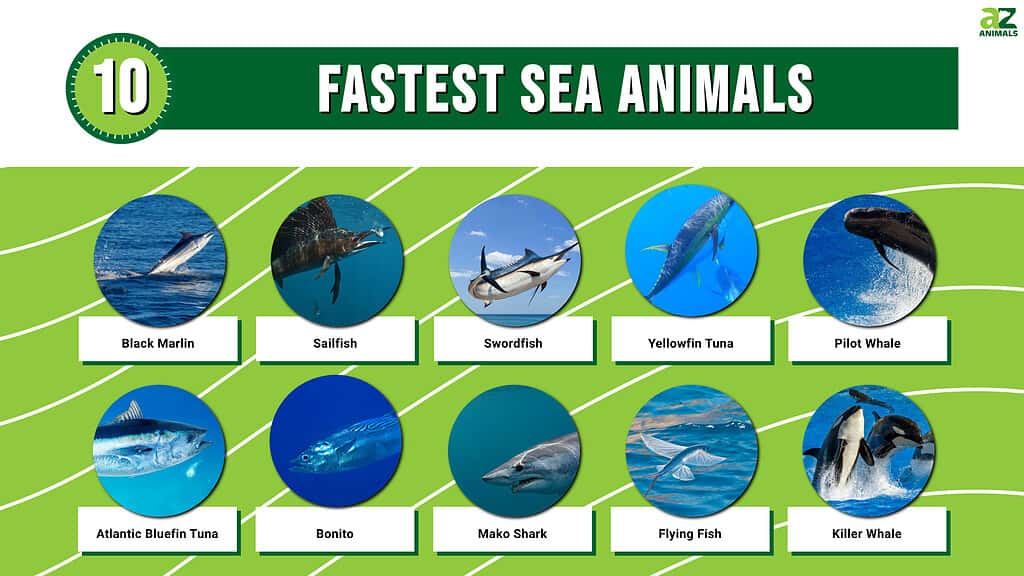
#10 Killer Whale – 32 mph

The orca can travel at 32 miles per hour when leaping out of the water.
©Andrea Izzotti/Shutterstock.com
Also called the orca, this beautiful marine mammal with its sleek black and white livery has been clocked at 32 miles per hour when leaping out of the water. An orca can grow to 31 feet long, and males are bigger and more robust than females. Males can also be told in the water because their dorsal fin is tall and erect, and the fins of the females gently curve. The black-and-white bodily coloration is also unmistakable.
The killer whale’s head is wide and round, and it has a large mouth with large, pointed teeth. It has paddle-shaped flippers that are large for the rest of its body. In the wild, the killer whale prefers cooler water just off the coast and can also move into rivers. It is found from the Arctic Ocean to the Caribbean and the Gulf of Mexico. Other populations are found in the Pacific Ocean around the equator.
The best places to see killer whales are in their natural habitat and some of the best places to spot them are Glacier Bay National Park, San Juan Islands, Vancouver Island, Peninsula Valdes, and Wilhelmina Bay.
#9 Flying Fish – 35 mph
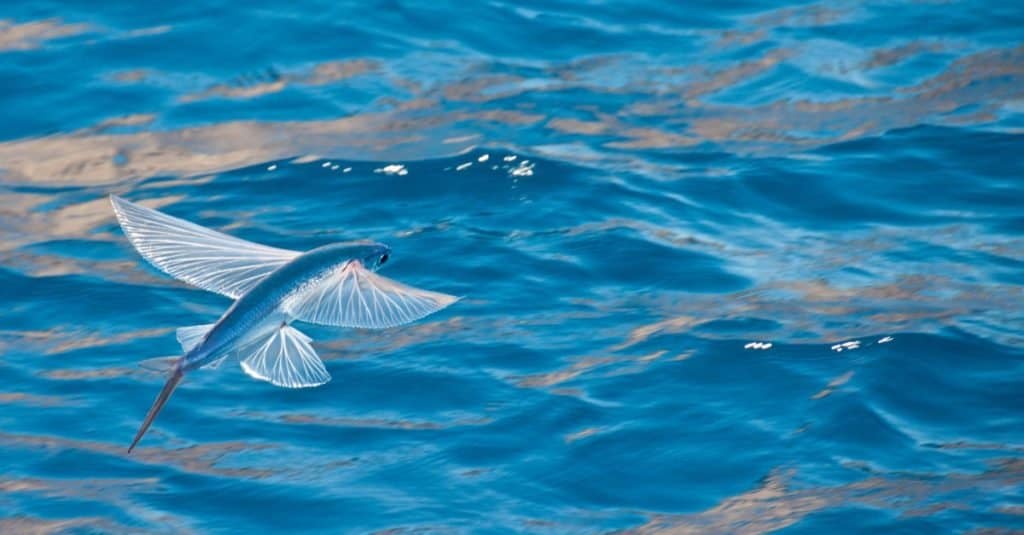
Flying fish actually do not have the ability to fly like birds, but they leap into the air and glide for short distances.
©Daniel Huebner/Shutterstock.com
Flying fish don’t actually fly, but they do leap out of the water while attaining speeds as fast as 35 miles per hour. Sometimes they leap so high that they land on boat decks. There are about 23 species of flying fish.
They have a torpedo-shaped body that allows them to move fast, pectoral fins on their sides and pelvic fins, and dorsal and anal fins far back on the body. The pectoral fins have become enormous and allow the fish to glide just above the surface of the water.
They’re found in the Atlantic from Maine down to the Gulf of Mexico and the Caribbean and south to Argentina. They can also be found in the Pacific from southern California down to Peru. Flying fish are popular prey for dolphins and billfishes such as marlins.
#8 Mako Shark – 40 mph
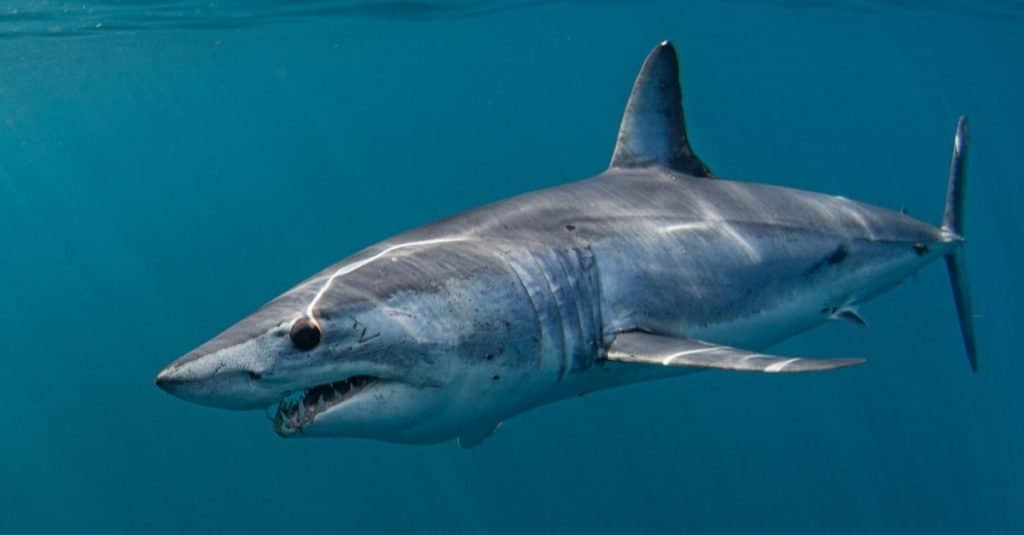
The mako shark can swim as fast as 40 miles per hour.
©Al McGlashan/Shutterstock.com
The mako shark is another fast, powerful, warm-blooded fish that makes good eating and is endangered. There are two species of this shark, which is related to the great white but is a bit smaller, being 8.2 to about 15 feet long and weighing as much as 1,400 pounds. Both mako shark species are torpedo-shaped, metallic blue on top and white on the bottom. The longfin gets its name because it has longer pectoral fins than the shortfin and has much larger eyes. Both have mouths full of sharp, haphazard-looking teeth.
The shortfin mako shark can be found around the world in seas that are both temperate or tropical, while the longfin mako prefers the warmer waters in the Gulf Stream. Both can be found offshore, swimming at the surface or to depths of around 490 feet. It can swim as fast as 40 miles per hour.
#7 Bonito – 40 mph

The bonito can reach speeds of 40 miles per hour.
©funny face/Shutterstock.com
The bonito is a small fish even though it can reach speeds of 40 miles per hour. It is a member of the mackerel family, and there is an Atlantic and Pacific species. The Atlantic bonito is three feet long, and its body, which is silver at the bottom and blue at the top, is long and compressed. It is found near the surface of temperate and tropical seas and close to the shore. It’s a migratory fish that ranges from Nova Scotia to Florida and the Gulf of Mexico and is sometimes found as far south as Argentina. The Pacific bonito has the same build but has stripes on its back and is found from Chile north to the Gulf of Alaska.
#6 Atlantic Bluefin Tuna – 43 mph
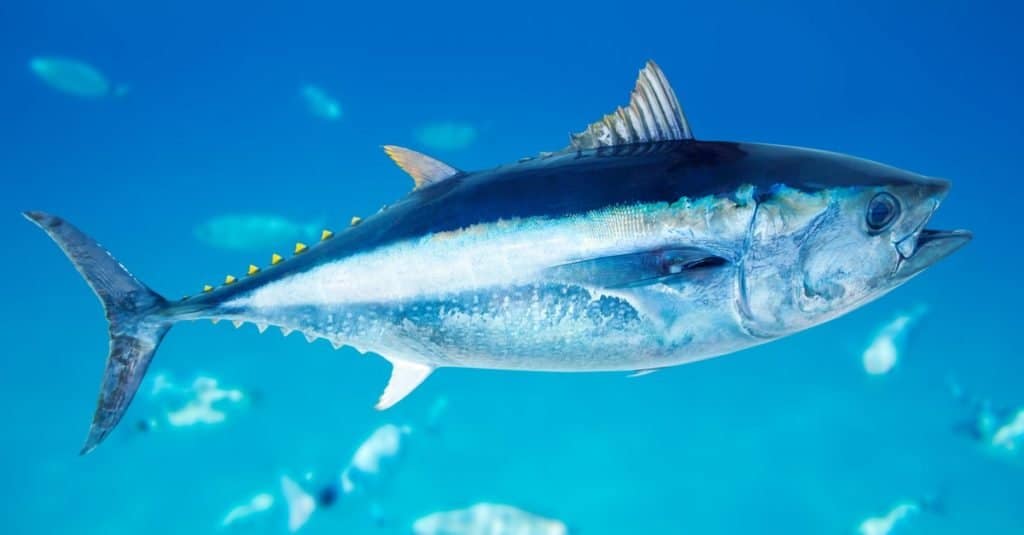
The Atlantic bluefin tuna is one of the largest, fastest, and most gorgeously colored of all the world’s fishes.
©lunamarina/Shutterstock.com
The bluefin tuna is an unusual fish, for it is warm-blooded. All tuna species are warm-blooded but the bluefin’s warm-bloodedness is exceptionally efficient. This is certainly one of the reasons why the fish is as fast as it is. The bluefin has been clocked at 43 miles per hour.
An adult bluefin can be between 6.6 and 8.2 feet long and weigh between 496 to 551 pounds, though the longest one was 12 feet long and weighed close to 1500 pounds. It is a powerful fish, can put up a fight for days, and can live to be 50 years old. A female bluefin tuna can produce 30 million eggs at a time. Still, this fecundity hasn’t made up for the fact that the bluefin has been overfished and is now endangered globally.
#5 Pilot Whale – 47 mph

Pilot whales are one of the largest members of the dolphin family and can reach 47 miles per hour.
©Andrea Izzotti/Shutterstock.com
Like the killer whale, the pilot whale is actually a large dolphin and can attain speeds of 47 miles per hour. Also called the blackfish, this animal is highly intelligent as well as fast. It is very social and is famous for inexplicably stranding itself on beaches. Its conservation status is least concern, but it is too often caught in nets meant for commercial fish.
It is a dark brown, dark gray, or black animal that can have a gray patch right behind its small dorsal fin. It’s also known for its melon, or its large, bulbous head. There are two species, the long-finned and the short-finned. The long-finned pilot whale can grow to about 21 feet long, with males about three feet longer than females. Male short-finned pilot whales grow to about 24 feet long and weigh over 3.5 tons. This makes their speed all the more impressive.
#4 Yellowfin Tuna – 50 mph

The yellowfin tuna is one of the open ocean’s fastest, strongest predators, and can swim 50 miles per hour.
©Al McGlashan/Shutterstock.com
Like the bluefin tuna, the yellowfin tuna is warm-blooded, and though its circulatory system isn’t as efficient as the bluefin’s, it appears that it can swim even faster at 50 miles per hour. It is found in warm ocean waters around the world and can grow to over 400 pounds. Its looks set it apart as well as its speed. It has very long, curved second anal and dorsal fins, which are yellow and give the fish its name. It also has yellow finlets down the stem of its tail or caudal peduncle. It is dark, shiny blue on top and silver on the belly, and the belly is striped.
This powerful fish is not just a fast swimmer, but a long-distance swimmer. It’s not unheard of for a yellowfin to swim straight across the ocean. It forms schools and often travels with other fish as well as porpoises and dolphins. Its flesh is delicious, and it puts up a good fight for sport fishermen. Unfortunately, this and commercial overfishing has made the yellowfin near threatened.
#3 Swordfish – 60 mph
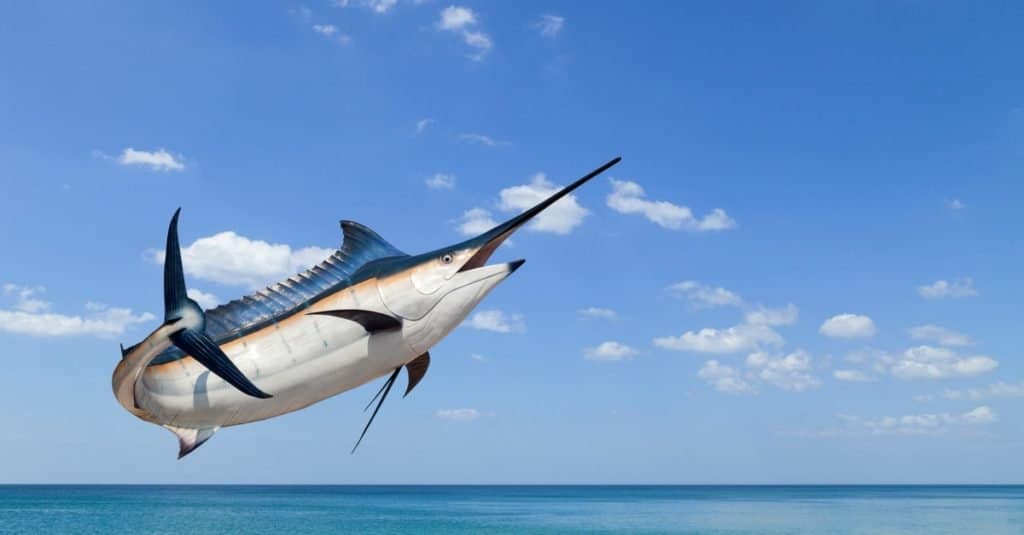
The swordfish’s long and compressed body allows it to swim up to 60 miles per hour.
©Stock High angle view/Shutterstock.com
The very fastest fish in the oceans are the billfish, and this includes the swordfish, named for its long, flattened beak, or sword. Like its relatives, the swordfish is torpedo-shaped and its long and compressed body allows it to swim through the water at up to 60 miles per hour.
The swordfish can grow to 15 feet long and weigh 1,182 pounds. Its first dorsal fin is tall and curved and the second is much smaller and very near its tail. It’s found near the shore and in open seas and can dive to as deep as 198 feet. It is found in the Atlantic from Newfoundland down to Argentina and in the Pacific from Oregon down to Chile.
#2 Sailfish – 68 mph
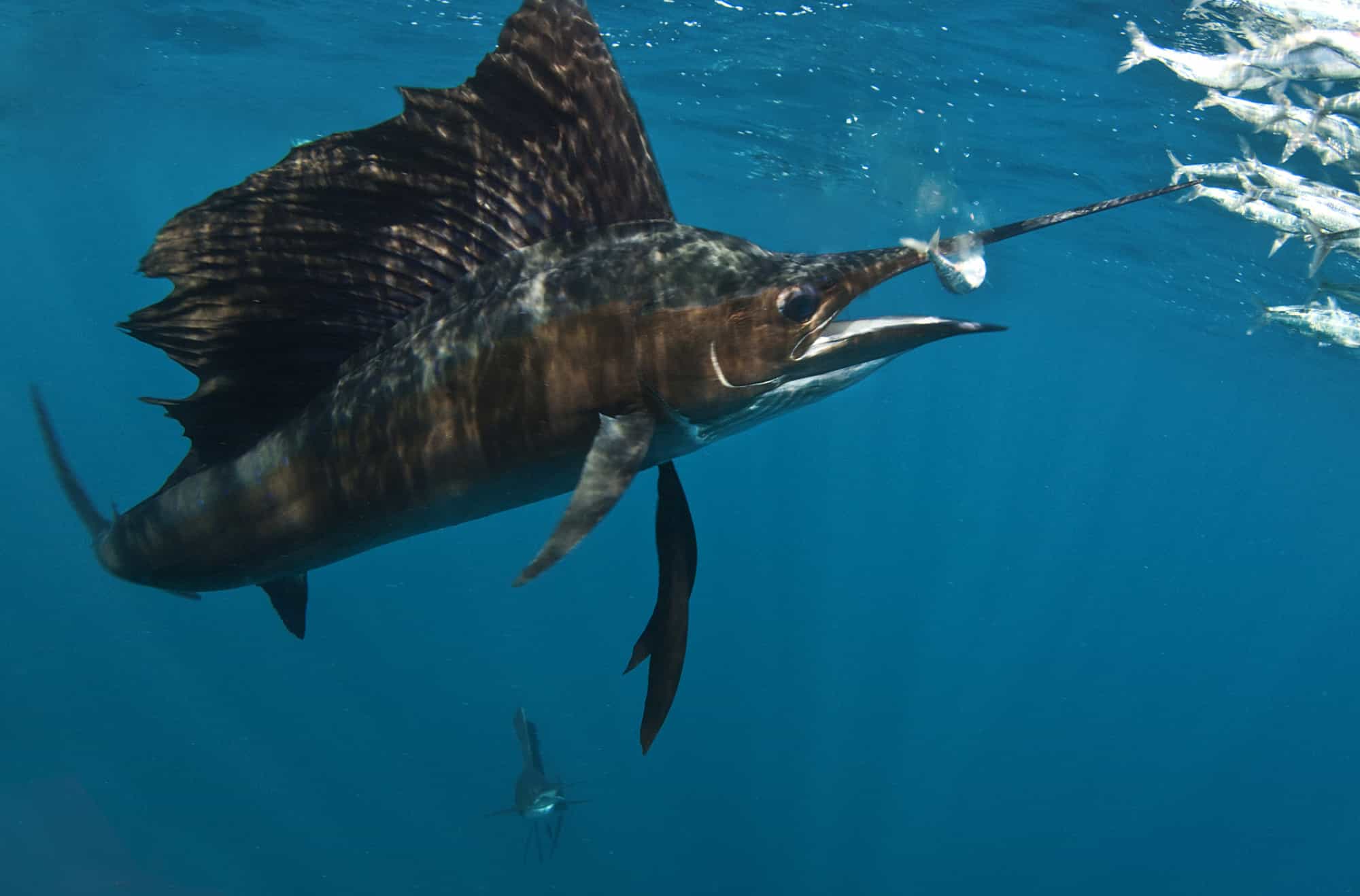
The sailfish is another billfish and can hit 68 miles per hour leaping out of the water.
©A Cotton Photo/Shutterstock.com
Another billfish, the sailfish, can reach speeds of 68 miles per hour as it leaps out of the water or plunges into a school of prey fish. This fish is smaller than the swordfish at around 11 feet in length, and it usually weighs only about 182 pounds. Like the swordfish, it has a compressed, long, tapering body. Its top is dark blue while its belly is silvery, and grown fish have rows of golden spots on their sides.
Its spectacular dorsal fin gives the fish its name, for it stretches nearly the length of the animal’s back. Not only this, it can be folded into a groove on the back to make the fish more hydrodynamic and is only put up when the animal is hunting. The sailfish uses its long bill to slash at its prey, and it’s either “left-billed” or “right-billed.”
#1 Black Marlin – 82 mph
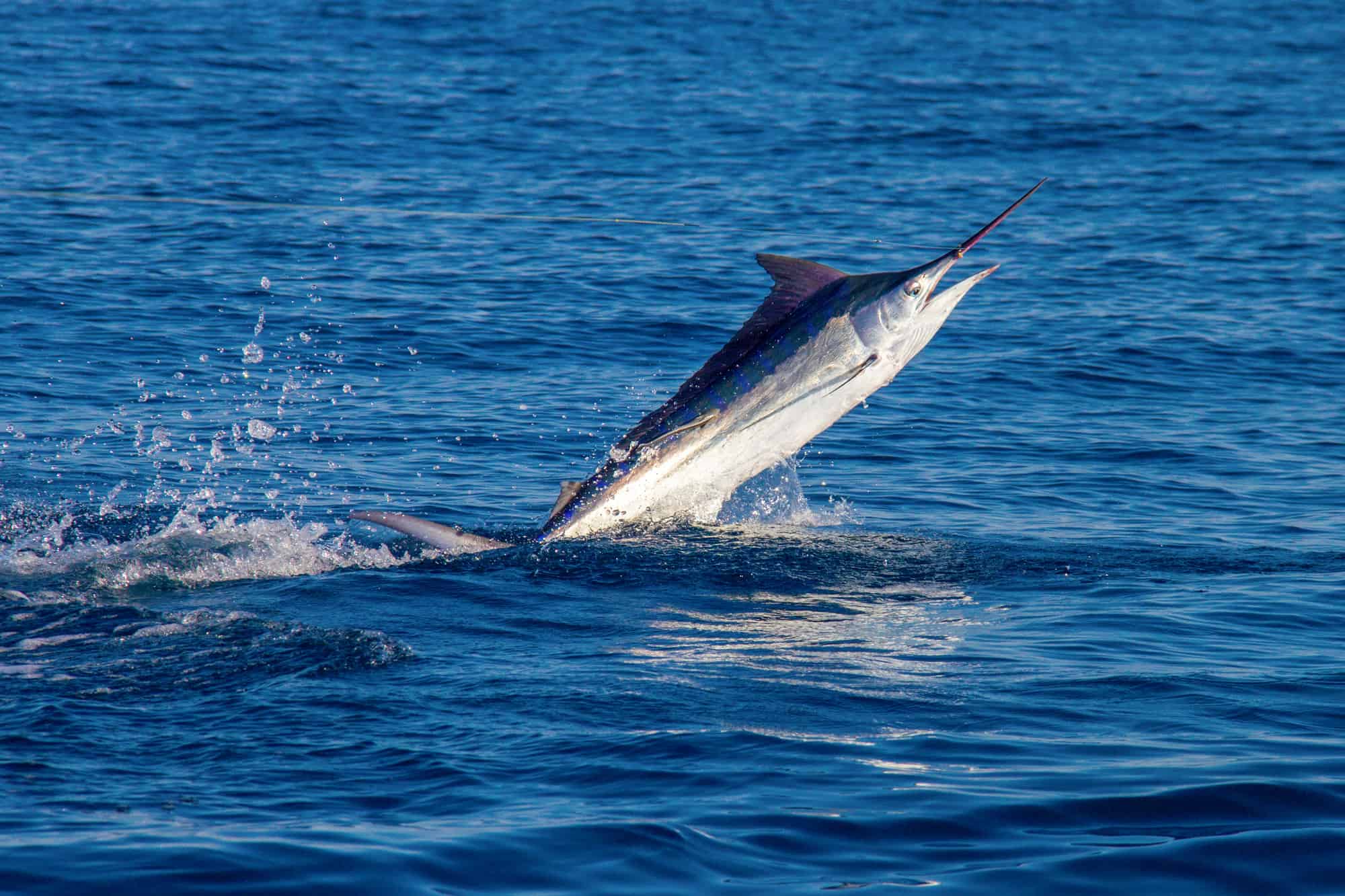
Black marlin is believed to be the fastest fish in the world due to one fish reportedly reaching 82 miles per hour.
©kelldallfall/Shutterstock.com
Though the sailfish is thought to be the fastest animal in the ocean, the black marlin may best it, and there is a story of one fish reaching 82 miles per hour. This fish is found in the warmer waters of the Pacific and the Indian Ocean and is a bit bigger than the sailfish at about 15 feet long. It is much heavier, with a weight of 1,650 pounds.
The 82 mph speed was put out by the BBC after a fisherman caught a black marlin on a line. They claim that the fish stripped the line off a reel at 120 feet per second, which suggests the fish was swimming at about 82 mph. But recent research has the black marlin currently clocked at a disappointing 22 miles per hour. Only time will tell if the black marlin’s record speed was a fish tale or not.
Black Marlin vs Sailfish: What’s the Difference?
These two fish compete for the fastest fish in the world title, with a specific black marlin winning by a significant amount. What makes it faster?
In contrast to the sailfish, the black marlin’s bill is relatively short, and its dorsal fin is low and rounder. Its pectoral fins are so rigid that they can’t be pressed against the fish’s sides to lower the amount of drag, which makes its speed that much more impressive.
Another reason the black marlin’s speed is so impressive when compared to that of the sailfish is its size. One would assume lighter is faster but not with these two. With the sailfish’s average weight being 182 pounds, the black marlin is humongous in comparison since it can weigh 1,650 pounds.
These billed fish also live in contrasting waters. The sailfish prefers shallow waters, no deeper than 300 feet. The black marlin, however, stays in deeper waters but close to the surface.
Lifespan: How Long Do Fish Live?
The lifespan of fish varies by species. A fish can live up to 200 years depending on the species, size, and location. Freshwater fish live anywhere from 1-10 years while wild saltwater fish may live 100 years.
The fastest sea animals on our list have varying lifespans. The black marlin may live 5-11 years. The sailfish can live up to 10 years. Our third fastest fish, the swordfish, lives about 9 years. The yellowfin tuna has a shorter lifespan with 6-7 years. In contrast, the male pilot whale may live 45 years while the female 60 years. The Atlantic bluefin tuna may live up to 20 years. The bonito lifespan is much shorter with 6 years.
Summary of the Top 10 Fastest Sea Animals
Here’s a recap of 10 ocean animals that break record speeds:
| Rank | Sea Animal | Speed |
|---|---|---|
| 1 | Black Marlin | 82 mph |
| 2 | Sailfish | 68 mph |
| 3 | Swordfish | 60 mph |
| 4 | Yellowfin Tuna | 50mph |
| 5 | Pilot Whale | 47 mph |
| 6 | Atlantic Bluefin Tuna | 43 mph |
| 7 | Bonito | 40 mph |
| 8 | Mako Shark | 40 mph |
| 9 | Flying Fish | 35 mph |
| 10 | Killer Whale | 32 mph |
Honorable Mention: Other Fast Sea Animals
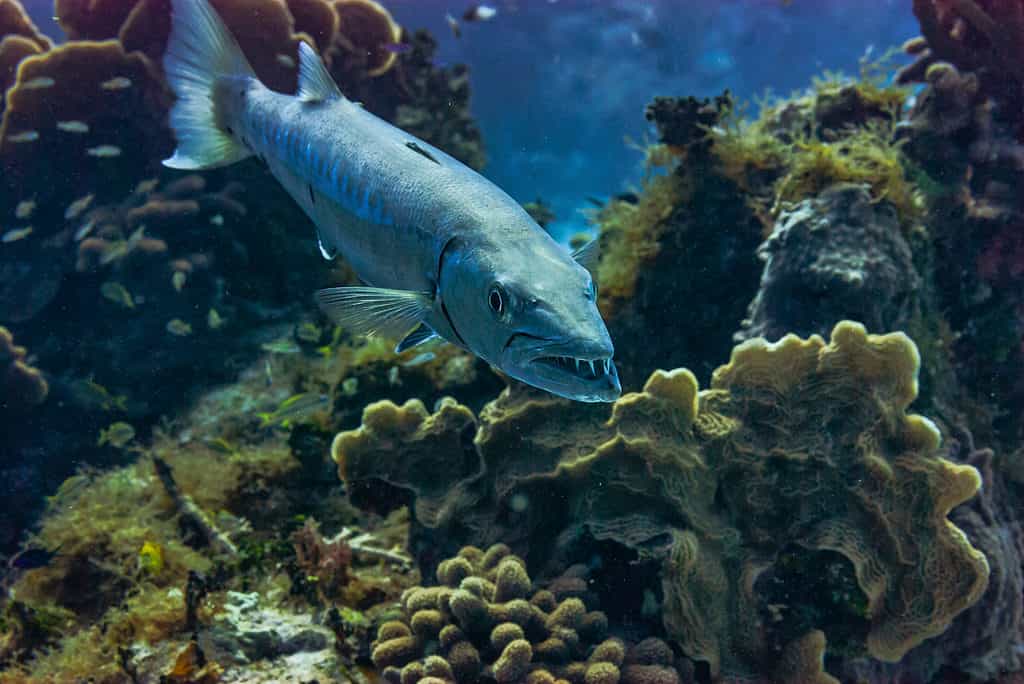
Great
barracuda
can reach over 100 pounds and is capable of reaching speeds of up to 35 miles per hour.
©Focused Adventures/Shutterstock.com
Oceans cover over 71% of the Earth’s surface and while scientists believe that there are over two million species residing in them, they have been able to find only about 240,000 of them. Even with this lesser number, it leaves a vast amount of animals to choose from when picking top speeds. Some of the animals that deserve recognition for their speeds are:
- Barracuda – these marine animals are nicknamed the ‘tiger of the sea’ and can reach speeds of up to 35 miles per hour in short bursts of speed. The great barracuda, which can often reach lengths of five to six feet, is capable of such high speeds due to its pointed snout and long tubular body.
- Tarpon – there are two species of tarpon in the family Megalopidae – the Atlantic tarpon (Megalops atlanticus) and the Indo-Pacific tarpon (Megalops cyprinoides). Tarpon are considered one of the most loved game fish in the world and are not only strong but fast, capable of swimming up to 35 miles per hour.
- Blueshark (Prionace glauca) – also known as the great blue shark, is found in both temperate and tropical oceans, this shark is capable of reaching speeds of up to 43 miles per hour. They prefer living in the deep, cold waters and can grow up to 10 feet. They are currently listed as Near Threatened by the IUCN.
The photo featured at the top of this post is © kelldallfall/Shutterstock.com
Thank you for reading! Have some feedback for us? Contact the AZ Animals editorial team.






